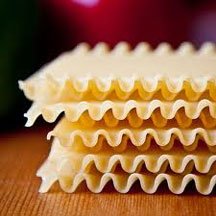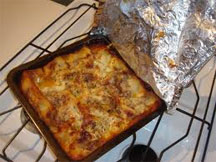Cook'n 101: Knoodle Know-How!
By Alice Osborne
 Sorry about that - couldn't resist the impulse to be cute. Anyway, let's talk about perfect pasta - lasagna noodles, specifically. There's more to knowing how to cook these noodles than one would guess.
Sorry about that - couldn't resist the impulse to be cute. Anyway, let's talk about perfect pasta - lasagna noodles, specifically. There's more to knowing how to cook these noodles than one would guess.
Because lasagna noodles are cooked twice, they can easily become too soft. If you use regular packaged noodles, don't wander away from the stove when you put them on to boil. The noodles should be removed from the heat and drained just before they reach the firm-tender stage.
 And they present more sticking problems than other pastas since they are so long and wide. With this going for them, it's easy for them to stick to each other in the pot. Also, considering they have to be set aside while the lasagna is being assembled, they like to stick to whatever surface they're on while they cool. Oh joy.
And they present more sticking problems than other pastas since they are so long and wide. With this going for them, it's easy for them to stick to each other in the pot. Also, considering they have to be set aside while the lasagna is being assembled, they like to stick to whatever surface they're on while they cool. Oh joy.
 So what to do? While adding a tablespoon or so of olive oil to the cooking water for most varieties of pasta should be avoided, it can be the right thing to do when cooking lasagna noodles. The oil helps prevent them from sticking together as they cook. The alternative is to cook just a few at a time, removing them with tongs when they're done. This is too much messin' around for me, though.
So what to do? While adding a tablespoon or so of olive oil to the cooking water for most varieties of pasta should be avoided, it can be the right thing to do when cooking lasagna noodles. The oil helps prevent them from sticking together as they cook. The alternative is to cook just a few at a time, removing them with tongs when they're done. This is too much messin' around for me, though.
When it comes to eliminating sticking during assembly, some cookbooks recommend rinsing the noodles in cold water after they are drained. But rinsing causes lasagna to become watery and to fall apart when cut. That's because rinsing away the starch eliminates its ability to absorb moisture during baking and "glue" the lasagna together. Also, if the noodles are not properly dried after rinsing, the excess water is absorbed and added to the liquid in the baking pan. Not good.
 The best thing to do is to simply drain the noodles and immediately lay them flat on cotton towels. The moisture on their steaming surfaces will evaporate quickly and the starch will be retained. Then assemble the lasagna quickly before the noodles have a chance to stick.
The best thing to do is to simply drain the noodles and immediately lay them flat on cotton towels. The moisture on their steaming surfaces will evaporate quickly and the starch will be retained. Then assemble the lasagna quickly before the noodles have a chance to stick.
 Don't you think lasagna is the perfect party dish? I love how it can be assembled several hours ahead of baking time and held in the refrigerator. One thing to note: If you bake yours straight from the fridg, add 10 or 15 minutes to your cooking time to compensate for its cool temperature. I also like to assemble two pans-worth, bake them both, then freeze one for later use.
Don't you think lasagna is the perfect party dish? I love how it can be assembled several hours ahead of baking time and held in the refrigerator. One thing to note: If you bake yours straight from the fridg, add 10 or 15 minutes to your cooking time to compensate for its cool temperature. I also like to assemble two pans-worth, bake them both, then freeze one for later use.
Hot tip: If you plan to freeze lasagna after baking, line the pan with enough heavy-duty foil to come up and way over the sides (so it will completely cover the dish). Bake as directed and cool completely before sealing the foil and freezing. Then after it's frozen solid, I remove it from the pan it's in, slip it into an appropriate-sized plastic bag and place it back in the freezer. This way I have my frozen lasagna and my dish to reuse now. Be sure to rebake within 3 months.
 To reheat, return the frozen lasagna to the original baking pan and thaw for about a day in the refrigerator. Undo the wrapping, but cover the lasagna loosely with the foil. Bake at 325 degrees for about 30 minutes or until heated through.
To reheat, return the frozen lasagna to the original baking pan and thaw for about a day in the refrigerator. Undo the wrapping, but cover the lasagna loosely with the foil. Bake at 325 degrees for about 30 minutes or until heated through.

